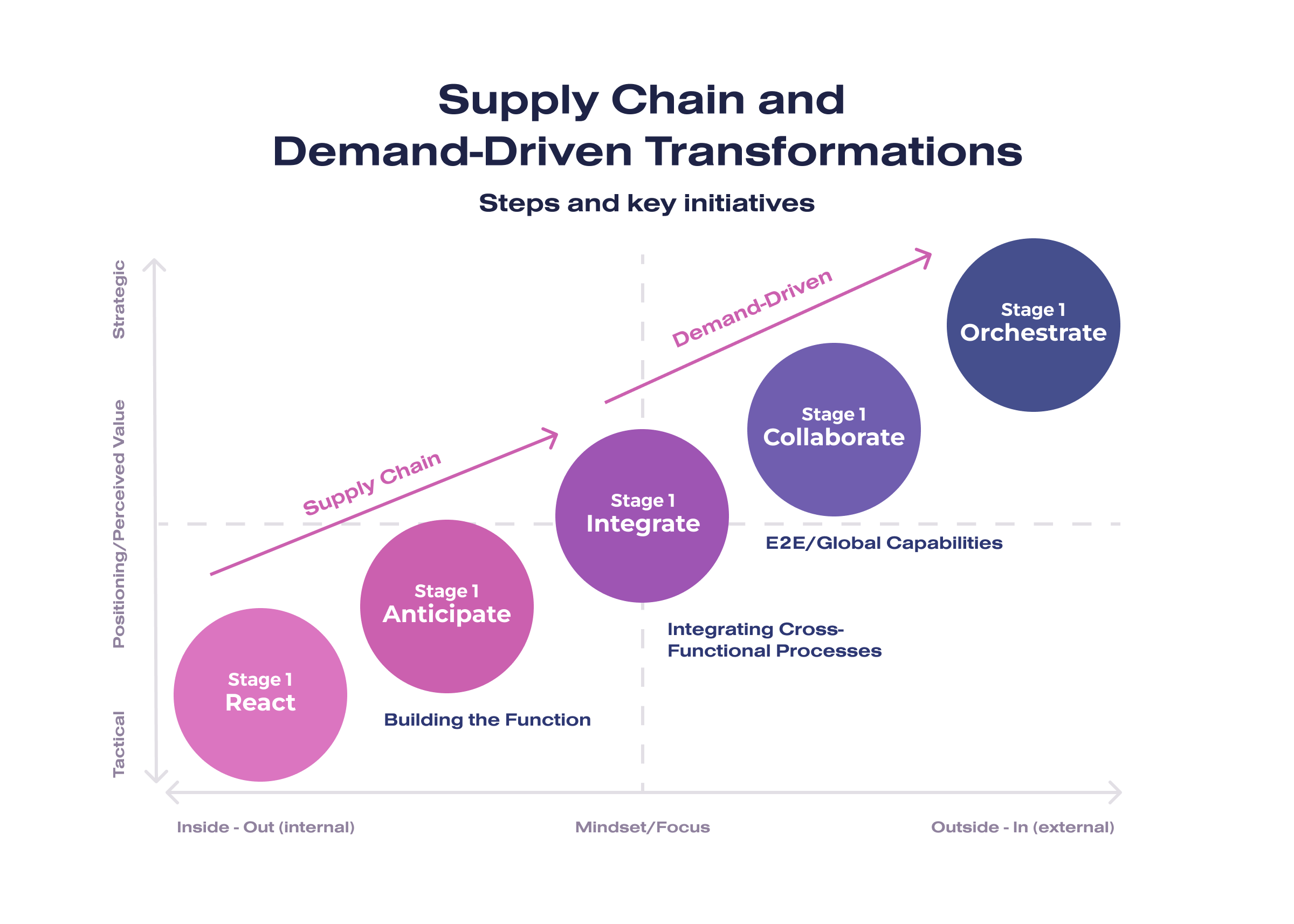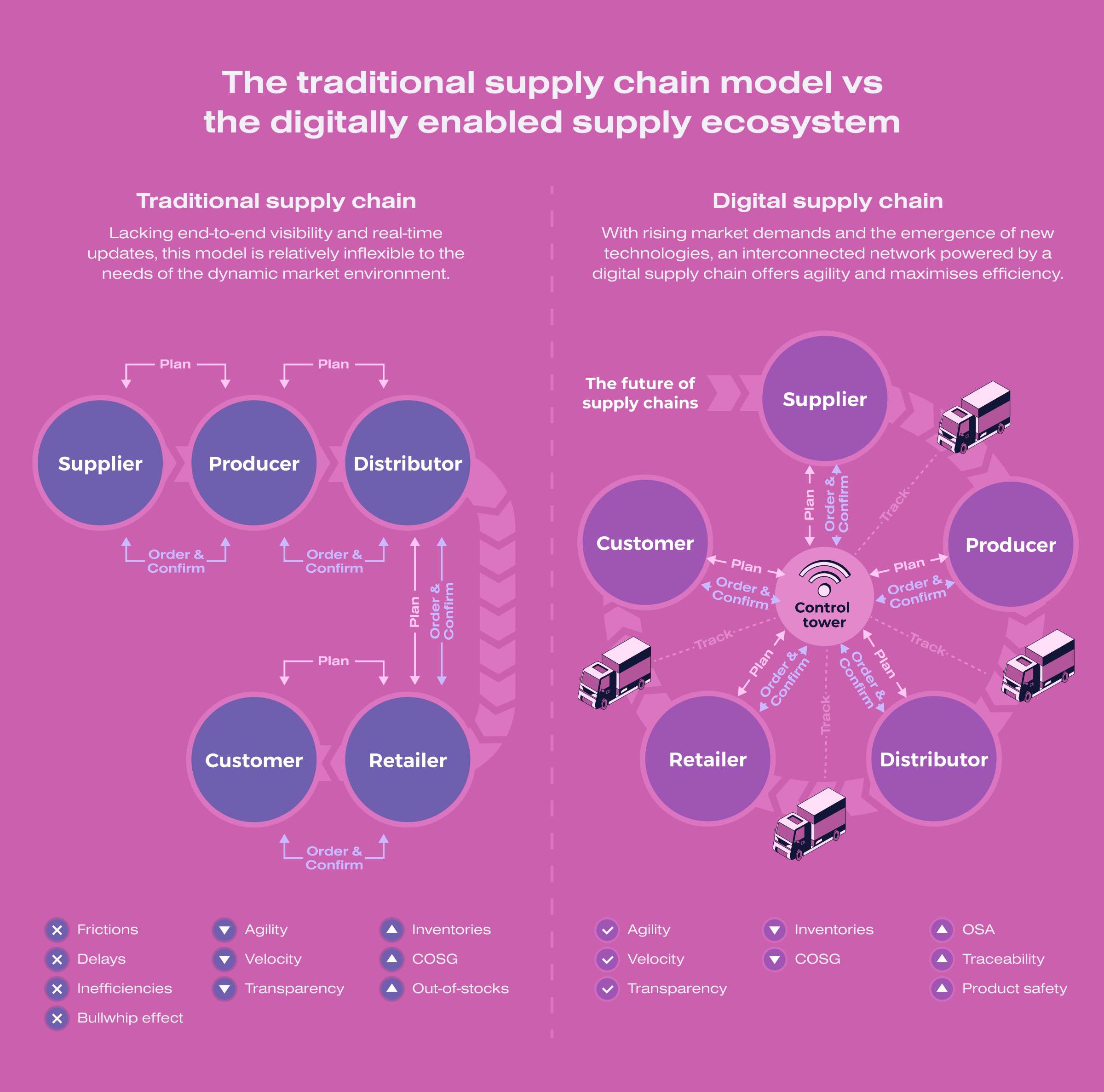Digital transformation is not a tribute to fashion but a necessity. It is a condition for the survival and successful functioning of an enterprise. This is especially true regarding manufacturing and material-intensive companies with complex supply chains. Everyone has heard the terms Big Data, Blockchain, and Internet of Things (IoT). These technologies are precious today for supply-chain digitalization. Those who manage production and would like their company to be on top will soon face supply chain digitalization.
This article discusses what is supply chain transformation, the peculiarities of supply-chain digitalization, and how to make your digital supply chain efficient.
Key points
What is supply chain transformation?
Digitalization refers to the process of converting information, data, or activities into a digital format. It involves using digital technologies to transform traditional analog or manual processes into digital ones. In all sectors of the economy, from material-intensive manufacturing to retail and services, digitalization is generally understood as 3 components:
- Interaction with the outside world. It is necessary to receive data from cameras, location tracking devices, and sensors on equipment. These data allow you to have the parameters of the real world in digital form.
- Accumulation and preparation of various data for processing. It includes everything from structured and semi-structured data to unstructured and binary files, including audio, video, and graphic data.
- Increasing the efficiency of production and inventory management processes. It is conducted based on Big Data analysis by identifying non-obvious patterns, solving optimization problems, and simplifying control.
Suppose you have a machine or production line. You installed additional sensors on it and now collect data on temperature, vibration, and other parameters to predict when some parts will start to fail and require replacement. In other words, you have a digital object, and with its help, you can, for example, switch to on-demand repairs and abandon scheduled repairs.
But to accomplish this, you need to plan the processes so that maintenance and repairs are carried out as quickly as possible with no downtime. Accordingly, the supply of necessary spare parts and the participation of specialists with the necessary qualifications must be timed to coincide with these works.

What are the peculiarities of supply-chain digitalization?
Where is the weakest link? A supply chain is only as effective as the weakest link. There is no point in trying to optimize the areas that are working well if there are laggards next to them that are not ready to join the new pace of work. This may result in unjustified stocking of raw materials or finished products. And the purpose of digital transformation is to avoid such problems.
Therefore, not only each machine but also each link in the supply chain must have an adequate digital twin. It must be used to model and evaluate business processes, where bottlenecks are formed, and how the requirements for providing raw materials and spare parts can be met. According to Precedence Research, the global digital twin market is projected to reach around $269.1 billion by 2032 with a registered CAGR of 38.7%. These statistics highlight the importance of digital twins.
You need a broad approach for supply chain digitalization. When the business digitizes a section of the supply chain and moves to digital management, it must be sure to assess the level of digitization of related processes. If, during the design process, the business realizes that it is missing data from adjacent areas (they are not digitized enough, not automated enough), it should be included in the project pool.
Suppose you have the results of analyzing the sensor data that it is time to service a machine tool. Still, you do not have information about the current stock of lubricants for this machine tool in the nearest warehouse. In that case, you can set up online monitoring of stocks in warehouses in parallel. This data alignment on all supply chain elements allows you to manage it efficiently.
Look for a reliable IT partner? We can help you digitize your supply chain!
How to make your digital supply chain efficient?

At SoloWay Tech, we highlight 5 mandatory aspects to consider to make supply chain digitalization effective.
Supply chain is managed from within an organization
A digital supply chain is, first and foremost, a set of operations or functions that are managed from within an organization. It can be functions performed within the company and by third-party contractors, suppliers, logistics, etc. Management must clearly understand the sequence of actions in the supply chain to meet the need for materials, resources, and raw materials on time.
Supply chain digitalization is needed to meet customer expectations
You digitize supply chain elements not only to ensure that production needs a clear and consistent supply of materials, parts, and raw materials but also to meet customer expectations for the timing of orders and finished products.
In metalworking, agricultural, and oil refining industries, there is often a stream planning, for example, the supply of raw materials. For project work like constructing an object according to an individual plan or installing equipment for an oil well, unique needs may need to be tracked individually.
If universal raw materials and supplies can be redistributed to different plants, making the same for a unique well unit is difficult. This procedure will involve third-party organizations, such as the facility designer and design institute, which must approve such redistribution. This is where supply chain digitalization greatly simplifies the planning process.
Pay attention to SLA (Service Level Agreement)
Service Level Agreement (SLA) consists of 2 parts. The first is the digital measurable parameters for which the supply chain is responsible as a service for internal or external customers.
The second is the transparency of the plan. For example, the customer should be able to see the progress of the unique product manufacturing for each order placed. He or she should also have access to a forecast of the final availability date of the entire order and the delivery date.
Digital tools allow timely and accurate communication of relevant information to the customer.
Allocate areas of responsibility for your digital supply chain
An organizational unit is often allocated to manage the digital chain and allocate areas of responsibility. It is a control center responsible to external and internal customers for the level of service and fulfillment of obligations. In front of the customer who actually orders services, this center is responsible for timing, quality, and cost. Internally, this center plans operations, assigns tasks, and controls execution at a given management horizon.
Come up with KPIs for your supply chain
In addition to the functions and sequence of actions, it is necessary to organize the KPIs and periodically verify them. Each link in the supply chain (production, purchasing, logistics, etc.) should be indicated at what speed, at what cost, and with what resources it is performed.
KPIs should consider, for example, the types of materials (bulk, liquid, etc.) or the degree of hazard. KPIs should be approached as an ongoing process that improves planning quality. At the same time, planning can start at a certain level of accuracy, gradually approaching a reasonable target.
Conclusion
SoloWay Tech is a team experienced in supply chain digital transformation with numerous case studies. Through digital transformation, your supply chain management will become:
- Proactive because incident solutions (prompts) will appear in real-time without additional specialist actions.
- Weighted because recommendation systems will start to work, offering solution options with an estimate of the cost of each of them.
- Trainable because the history of previously made decisions will be used.
- Fast-executing due to the automatic execution of routine operations.
These are the properties that ultimately lead to enterprise efficiency and competitive advantage. Only with digital and verified individualized IT solutions can you expect improved results, which were not achieved by previously accepted approaches.




